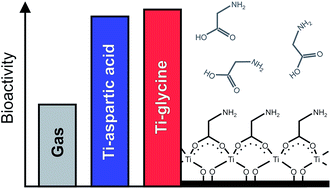Bioactive titaminates from molecular layer deposition†
Abstract
Organic–inorganic hybrid materials are an emerging class of materials suitable for deposition by the molecular layer deposition (MLD) technique. Their toolbox is now expanded to include linkers of amino acids, which when combined with titanium form materials that can be termed titaminates, based on the amine and carboxylates present in the amino acids being used as linkers. This is a class of compounds with high potential as bioactive materials, containing essential amino acids and biocompatible titanium. The films have been prepared by combining titanium tetra-isopropoxide (TTIP) with glycine and L-aspartic acid. L-Arginine has also been used, however, without success. Hybrid films of TTIP and succinic acid were also investigated as a comparison to L-aspartic acid due to their structural similarities. All systems show self-limiting growth with a reduction in the growth rate with increasing temperature. The as-deposited films are amorphous, have low surface roughness, exhibit a hydrophilic nature as measured by a goniometer, and bear indications of some porosity towards water. Films based on glycine and L-aspartic acid have been used as substrates for growth of epithelial cells (rat goblet cells) where their proliferation has been monitored. The cell proliferation was significantly increased on these substrates compared to uncoated coverslips.



 Please wait while we load your content...
Please wait while we load your content...